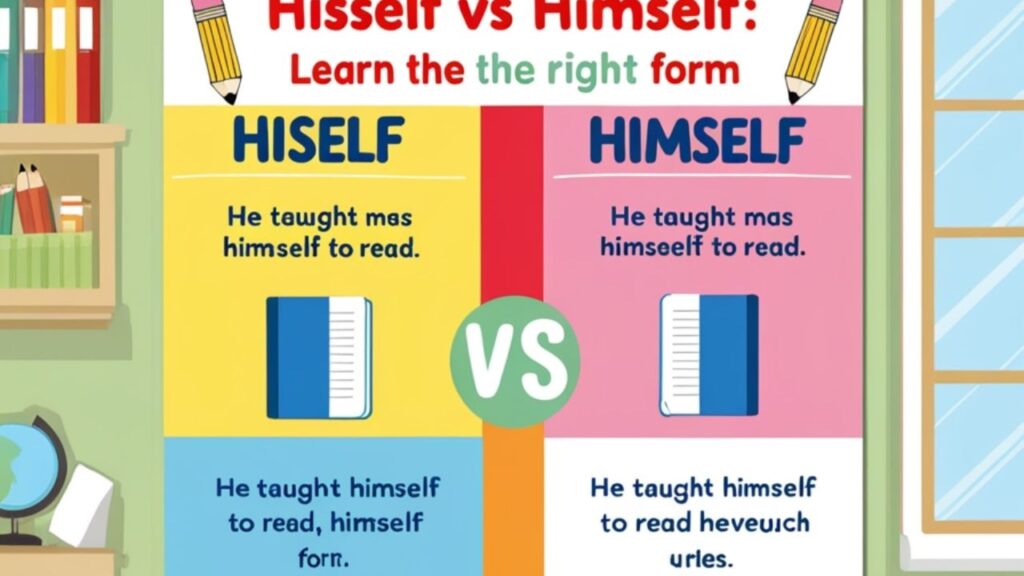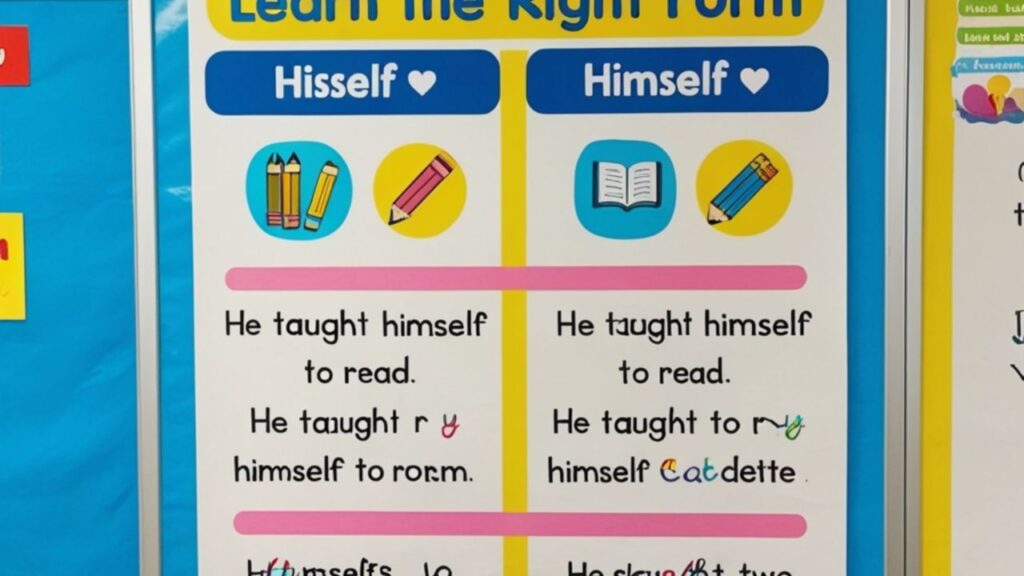Hisself is a word many people say, but it isn’t correct in proper English. The right word is himself, which we use when someone does something to their own self. Using the correct word makes your sentences clear and helps you speak and write better.
The word himself follows English grammar rules. It is used after “he” in a sentence. For example, “He hurt himself while playing.” This makes the meaning clear. Learning to use the right word builds strong writing habits and confidence.
Some people still say hisself because they hear it in their homes or towns. But in schools and books, everyone uses himself. It’s good to learn and practice this form every day so you always speak and write correctly.
Understanding Reflexive Pronouns: A Quick Refresher
Reflexive pronouns show that the doer and the receiver of an action are the same person. Words like myself, yourself, and himself belong to this group. They make sentences simple and clear by joining the subject and object together in one smooth idea.
We use reflexive pronouns to show actions done alone. For example, “She taught herself to read.” These words also give strength to meaning. They help children write properly, understand grammar rules, and build confidence in using correct English every day.
| Subject Pronoun | Reflexive Pronoun |
| I | myself |
| you | yourself |
| he | himself |
| she | herself |
| it | itself |
| we | ourselves |
| you (plural) | yourselves |
| they | themselves |
The Standard: What Makes ‘Himself’ Grammatically Correct
“Himself” is the only standard, grammatically correct reflexive pronoun used for the third person singular masculine subject “he.”
Historical Background:
The word himself came from very old English. People have used it for hundreds of years in books and speech. It grew from two small words, “him” and “self.” This form stayed the same through time because it follows clear grammar rules.
Writers in early English stories and poems also used himself. It became part of standard grammar in schools and writings. Learning this history helps children understand why himself is the right word and why older forms slowly disappeared from use.
- The word himself came from Old English, formed by joining “him” and “self.”
- It has appeared in literature and writing for more than a thousand years.
- Early grammar books accepted himself as the correct reflexive form.
- Over time, himself stayed standard while “hisself” slowly faded away.
See also : Unselect vs Deselect: Which Term Is Correct for UI?
‘Hisself’: A Nonstandard Variation Explained

Despite the authority of “himself,” the term “hisself” continues to pop up. Here’s why.
Origins of ‘Hisself’:
- The word hisself appeared in some regional English dialects many years ago.
- It came from combining “his” and “self” by sound rather than grammar rule.
- Speakers in certain areas of the Southern United States often used it.
- Linguists link hisself to informal speech and cultural language patterns.
Why it’s Nonstandard:
- The word hisself does not follow English grammar rules for reflexive pronouns.
- It replaces “him” with “his,” which changes the correct word pattern.
- Grammar books and dictionaries mark it as incorrect in formal writing.
- Teachers and editors recommend using himself in all proper communication.
Grammar Rules Backing the Use of ‘Himself’
To understand why “himself” is correct and “hisself” isn’t, you need to understand how reflexives are constructed in English.
Construction Pattern:
- A reflexive pronoun is made by joining an objective pronoun with “self” or “selves.”
- Examples include “me” + “self” = myself and “him” + “self” = himself.
- The possessive form like “his” cannot join with “self.”
- Correct reflexive forms always match the subject of the sentence.
Grammar Tip:
- Always match the reflexive pronoun with the correct subject form.
- Use “himself” after “he,” not “hisself” or “his self.”
- Read sentences aloud to check if they sound correct and natural.
- Practice writing short examples daily to remember proper grammar use.
Real-Life Usage: ‘Himself’ in Correct Sentences
- He taught himself to draw beautiful pictures using online videos.
- The boy looked at himself in the mirror before going to school.
- The teacher praised him for helping himself during class work.
- The cat cleaned himself after eating its food.
- He challenged himself to finish the homework without help.
Why ‘Hisself’ Persists in Spoken English
You might hear “hisself” in casual conversations, but that doesn’t make it right. Here’s why it’s still around:
Regional Usage:
- The word hisself is often heard in parts of the Southern United States.
- It appears in stories, songs, and local speech in some rural areas.
- Many speakers use it naturally when talking with family or friends.
- It reflects local culture and spoken language traditions.
- Teachers still guide students to use himself in formal writing.
Language Evolution:
- The English language changes over time as people speak in new ways.
- Words like hisself show how speech can differ between regions and groups.
- Grammar rules stay steady even while spoken forms shift.
- Dictionaries record these changes to study language growth.
- Learning proper forms like himself keeps writing clear and correct.
‘Hisself’ vs ‘Himself’: A Comparison Table
| Feature | Himself (Standard) | Hisself (Nonstandard) |
| Accepted in formal writing | Yes | No |
| Found in dictionaries | Yes | As dialectal only |
| Regional usage | Nationwide | Mostly Southern US |
| Recommended by grammar experts | Yes | No |
| Reflexive pronoun status | Standard | Incorrect |
Analogy-Based Explanation for Easier Understanding

Think of reflexive pronouns like family pairs that always stay together. “I” goes with “myself,” “she” goes with “herself,” and “he” goes with “himself.” Each pair follows a pattern that keeps English sentences clear and easy to understand.
Using an analogy helps children remember grammar rules. It’s like matching shoes—each one fits only its partner. When learners connect words correctly, their writing becomes smooth. This simple comparison makes grammar lessons more fun and easier to remember.
Analogy:
Just as you wouldn’t say “herself” as “herselfs,” you shouldn’t say “hisself” instead of “himself.”
Trick to Remember:
- Think of “he” always joining with himself, not “his self.”
- Say it aloud to hear which form sounds natural and correct.
- Remember: possessive words like “his” never take “self.”
- Write short sentences using himself for daily practice.
- Use grammar tools to check and learn from your mistakes.
See also : “Among Others: Meaning, Grammar, and Smart Examples”
Practical Tips to Remember the Right Form
Here are some simple tricks to always get it right:
Mnemonics:
- Remember this line: “If it’s him, it’s himself.”
- Think of “his self” as two words that don’t belong together.
- Picture “himself” as one strong team working as one.
- Link it with “herself” and “myself” to see the same pattern.
- Repeat short phrases using himself to fix it in memory.
Usage Hacks:
- Remove the reflexive word to test correctness; “He blamed” works, so add himself.
- Avoid adding “self” to possessive words like “his.”
- Read your sentences aloud to spot grammar slips.
- Use writing apps that highlight wrong forms like hisself.
- Practice short exercises using himself until it feels natural.
Tech Tools:
- Grammar checkers like Grammarly mark hisself as incorrect instantly.
- Microsoft Word underlines wrong reflexive forms during typing.
- Online dictionaries explain why himself is the right word.
- Language learning apps give examples using proper grammar.
- Spell-check tools help young learners write with confidence and accuracy.
Common Errors and How to Fix Them
Top Mistakes:
- Writing hisself instead of himself in school assignments or essays.
- Copying spoken language directly into formal writing.
- Forgetting that reflexive words use the objective form, not possessive.
- Mixing up words like “his self” and “himself.”
- Ignoring grammar corrections from teachers or writing tools.
Correction Tips:
- Read sentences slowly to spot and fix wrong reflexive forms like hisself.
- Replace every incorrect word with himself when reviewing work.
- Practice daily writing using short, correct examples.
- Listen carefully to teachers’ feedback during grammar lessons.
- Use online tools to check and improve sentence accuracy.
Expert Opinions and Linguistic Insights
What Grammar Experts Say:
Many grammar experts agree that learning correct word forms helps children write with confidence. They teach that “himself” is the right choice in proper English. Their advice guides students to use standard words that make sentences clear and meaningful in every subject.
Teachers and grammar experts explain that good grammar builds strong language skills. They remind learners to follow simple patterns in writing. With daily practice and reading, young students quickly understand how correct word use improves both speech and writing quality.
Linguist Insight:
A linguist insight shows how people learn and use language in daily life. Experts study how children pick up words from hearing others speak. They find that correct examples at home and school help learners form strong habits in speaking and writing.
According to linguist insight, language grows through practice and listening. When students hear proper grammar often, they remember it better. Clear teaching and reading aloud strengthen their understanding of English rules and make learning enjoyable for every young learner.
Final Thoughts
In final thoughts, learning correct grammar helps children speak and write clearly. Knowing how to use words properly makes every sentence strong. Small efforts each day, like reading and writing, build lasting language skills that support good communication everywhere.
Teachers remind students that careful word use shows respect for language. Following final thoughts from lessons helps learners grow confident. When children use correct grammar, they share their ideas easily and make learning English an enjoyable part of everyday life.
FAQs
Why himself and not hisself?
“Himself” is grammatically correct; “hisself” is nonstandard and considered incorrect in formal English.
Is hisself a common grammatical error?
Yes, “hisself” is a common mistake, mostly used in dialects or informal regional speech.
Should I avoid using “hisself”?
Yes, avoid it in writing or formal speech; use “himself” for correct grammar.
Is it introducing himself or hisself?
It’s “introducing himself,” the grammatically correct and standard form in English.

Join Bibcia on a journey to master English grammar. Discover easy lessons, writing tips, and practical examples designed to make learning grammar simple and effective.










